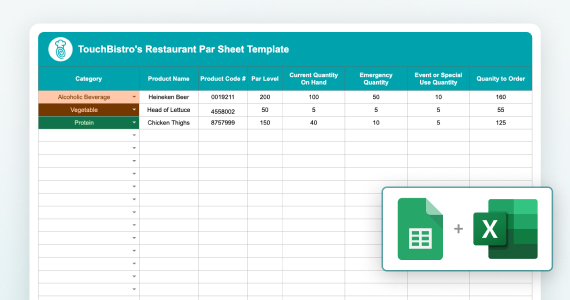Think of your menu as your restaurant’s central hub: it determines your storage needs, equipment requirements, back of house staff skills, and, finally, your restaurant inventory list. Your restaurant’s operations are at the mercy of your menu, so it’s important to design your menu with the goal to scale operations, prevent waste, and turn a profit.
Before working with suppliers, you’ll need to create a restaurant inventory list based on your menu and recipes. Remember when you began the creative work of generating ideas for your menu and testing them for your target market? Now’s the time to use what you’ve learned to select your final dishes. From there you’ll be able to organize your inventory list so you can start getting quotes and ordering from suppliers.
In this section, we’ll tell you how to finalize your menu and create your restaurant inventory list.

Use this restaurant par sheet template to keep track of how much kitchen and bar inventory you must have at all times, and the amount to order from your vendors.
Finalizing Your Menu
Your inventory is tied to your menu, and any decisions you make about your menu will affect the procurement of your ingredients. When choosing your final dishes, you’ll want to strike a balance between creativity and practicality.
Review your recipes for rare ingredients.
After you’ve tested some of your menu items and have a general idea of what you’d like to include on your final menu, run through each recipe and make special note of rare ingredients. How many do you have? If you have a large list of ingredients that are difficult to procure – say, you would need to work with 10 different suppliers to get them – it may be time to make some sacrifices for the sake of simplicity and cost.
Always go back to your business plan at this stage. Which specialty ingredients do you need to properly execute your core concept? Which specialty ingredients can you eliminate to keep costs down? Research ballpark numbers for the cost of each item so that you can prioritize what you need versus what it might be nice to have.
reminder: you want to start small and scale up, not start big and scale down!
Note areas of potential cross-use for rare ingredients.
If your concept is dependent on specialty ingredients, make sure you’re using them in more than one recipe. If you’re using an ingredient in only one recipe, you’re likely throwing away a lot of money.
An example: yuzu, a Japanese citrus juice, is very expensive; a one litre bottle can cost up to $40. If you included only one dish that contained yuzu on your menu and it turned out it wasn’t a big seller, you may end up throwing away half the bottle – meaning you’ll be throwing away $20 every month.
You may not need to include the same ten ingredients in every dish on the menu, but it’s smart to incorporate rare ingredients into at least two dishes. Another option is to feature daily specials that use rare ingredients so they don’t go to waste.
Consider storage requirements for each ingredient.
Remember to design your menu alongside the setup of your kitchen – especially when it comes to storage. Run through your recipes and group together ingredients that can be stored together. You’ll start to notice a pattern that will help guide your storage requirements. For example, if you plan to serve a lot of fresh fish and seafood, you may need a separate walk-in refrigerator for these items.
Make a list of seasonal ingredients.
Which ingredients won’t be available all year round? Knowing availability fluctuations ahead of time will help you plan long term for seasonal turnover and cost variability. If some of your menu items aren’t available fresh all year round, you may need to plan to switch to frozen during the off season. Project how much each shift will cost by comparing each ingredients fresh variation to its frozen one, and you’ll know whether or not you’ll need to raise the price on some items to make up for the higher cost of ingredients.
Notice how many times you use ingredients across recipes.
Examine each of your recipes and make note of the number of times you use each ingredient. First you’ll want to make sure there’s enough variety on your menu to please a variety of tastes, but you’ll also want to be aware of which ingredients show up the most. If you’ve discovered that chicken makes a prominent appearance, you may need to shop for suppliers who are known for high-quality or low cost chicken.
Know the shelf life of your ingredients.
If you’re stocking up on a lot of ingredients with a short shelf life, you’ll likely be facing a lot of waste. You can’t assume your staff will always properly rotate those items that spoil faster, so you’ll need a rock solid inventory management system to make sure you’re not wasting money on high cost items that have a short shelf life. Make sure to design your menu with this in mind; delicate menu items that spoil quickly should not make up a large portion of your menu, but rather be balanced with items that tend to keep longer. Restaurant waste can really eat into your profit margin, so being aware of this issue now is crucial to the future of your business.

Use this restaurant par sheet template to keep track of how much kitchen and bar inventory you must have at all times, and the amount to order from your vendors.
Stocking a Restaurant
After you’ve finalized your menu, it’s time to create your restaurant inventory list a.k.a. spreadsheet.
Restaurant inventory list essentials:
- Category + name of ingredient
- Unit of measure
- Amount required
- Unit price
- Total cost
Once you’ve set up your spreadsheet, here’s how to fill it in to generate your final restaurant inventory list.
List all of your items.
Write down all your ingredients under their respective categories.
Write down the unit of measurement for each item.
Your unit of measurement will depend on how an item is usually sold in bulk. For example, you may be buying cheese by the pound but tomato sauce by the ounce. If you know you’re buying produce by the case, that would be your unit of measurement.
Estimate how many of each item you’ll need.
At this point, you’ll need to rely on your sales projections to estimate how much you’ll need of each item. Expect this process to include some trial and error; during the first three months of business, you’ll overbuy and underbuy inventory. Keeping track of your inventory and waste during these months will help you refine your inventory list after you’re open for a while.
List the cost for each unit.
This part will need to happen after you’ve compared quotes from suppliers and settled on where to buy your ingredients.
Multiply the unit price by the inventory amount.
This will be the cost of the ingredient for your designated purchasing period (likely a week).
After you’re open, repeat the process weekly.
Keeping an updated inventory list after you’re open can mean the difference between a profitable business and a struggling one.
pro tip: purchase a point of sale that doubles as an inventory management system. using a pos instead of a spreadsheet to keep track of ingredient inventory is a much more precise method of monitoring levels and preventing waste. it will allow you to remove a lot of the manual tracking, since it automatically updates the inventory levels based on what items have been sold.
Conclusion
Make it a point to know your menu like the back of your hand. Know its required ingredients, how you buy them, their cost, and how quickly or slowly they’re used up in your restaurant. The restaurant owner who knows their inventory is the restaurant owner who’s more likely to remain in business. When you continue to refine your processes for taking accurate inventory, you’re also taking steps to spot any red flags before the point of no return for your restaurant.
Sign up for our free weekly TouchBistro Newsletter





